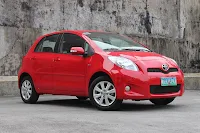 |
| Photos by Ulysses Ang |
I have driven over 350 cars in the 15 years I’ve been a motoring writer, and though I could instantly fill up an entire Excel sheet with the different pros and cons of each car, there are some which have simply transcended the simple negatives and positives, and one of them is the Yaris. I won’t mince words, it’s not a perfect car, but it nonetheless remains close to me. So when an opportunity came for me to drive the Yaris once more, I quickly jumped at the chance. But is the love as strong as it was before or has it faded?
As a product, the Yaris is exceptionally packaged. With an overall length of just 3,800-mm, it actually fits a 2,460-mm wheelbase which is the same as the pre-Altis Corolla. The surprisingly roomy cabin fits five adults with comfortable breathing space even for an out-of-town trip. Everything in here was designed to maximize space. Upfront the swept up power window switches and the anorexic center console with vertically stacked air conditioning controls frees up knee room. Meanwhile, at the back, the door mounted window switches and flat floor enables the rear occupants to stretch a bit.
Despite the conscious effort to prioritize passengers, Toyota didn’t forget what set the Yaris’s predecessor, the Echo, apart from the sub-compact hatch also-rans of years ago: tons of cubby holes. And the Yaris continues to set the benchmark: three glove boxes including one right behind the steering wheel, three storage bins flanking the center console plus two storage racks at driver’s knee level. This car could have scored perfect if only it had a split-folding rear bench. Sadly, Toyota provided a single folding unit and the lockable storage bin of the pre-refresh Yaris is now gone.
Though the lockable cargo storage bin has bit the dust, the Yaris’s interior does receive revised fabrics and materials. For instance, the ventilation controls now have soft-touch plastics and chrome highlights. The steering wheel and shift knob are particularly interesting since they’re now covered in leather and offer controls to the audio system (which oddly enough, don’t light up with the rest of the cabin buttons). The thick three-spoker is also flat-bottomed with red leather stitching for that sporty effect.
Outside, this bolder and sportier appearance is echoed in the Yaris’s redesigned front bumper with a tapered and angular front fog lamp openings and a smaller, sleeker mesh grille. At the back, the rear bumper appears more square-cut with new “reflex” reflectors. The headlamp and tail lamp clusters have been modified, with the latter benefitting from the return of LED brake lamps (sans the rear fog lamp which has also disappeared). The exterior changes are capped off by a standard rear spoiler, side mirror integrated turn signal indicators, and a large chrome tail pipe finisher.
After settling into the driver’s seat once again, it was time to get re-acquainted with the Yaris. With 105 horsepower, it’s no more powerful than its contemporaries, but the 4-speed automatic squeezes most out of the engine. The Yaris never lacks punch, and can accelerate reasonably well even when fully loaded. The engine also doesn’t give the sportiest exhaust note, but the speedometer needle tells the story of a car that dispenses speed quite easily. It has an Achilles’s Heel though, and that’s a lack of power in the all-important 60-80 km/h—the overtaking speed. The Yaris feels lively at any speed below or above that. By far though, the most fun thing with the Yaris is how it can carve through city traffic. Visibility is excellent and with a quick-ratio electric power steering, it can squeeze through two cars with an almost motorcycle-like manner (usually to the ire of other motorists). Plus, it can turn on a dime into the tightest parking spaces.
Clearly, the city driving aspect of the Yaris hasn’t worn out on me. As I average around 350 kilometers a week, this car manages to be a dependable and eco-friendly companion—sipping fuel at the rate of just 10.88 km/L. However, as the crowded Manila streets turned into four-lane highways, the Yaris’s city car design flaws start to emerge. Not lacking in top speed, the Yaris tops out at an electronically-limited 130 km/h. What’s discontenting is the way it can get swept by crosswinds because of its lithe mass. The overly sensitive steering poses as a problem too; because keeping the Yaris pointed straight at high speed takes some concentration. Lastly, because the 4-speed gearbox is tuned more for acceleration than top speed, the Yaris’s highway fuel economy barely improves over its city figure, topping out at just 13.33 km/L.
Technology gets old. Fashion comes and goes, but after getting back together with Debbie, or at least an improved version of her, I have little to complain about. She’s mechanically alright with all the necessities you could absolutely think of in a simple, straight-forward small car. Perhaps by adding a split-folding rear bench and a standard USB audio input, you can call it perfect. However, you cannot ignore that the Toyota Yaris is already nearing the end of its product lifecycle, but at P 771,000 it remains as a commendable first car, especially for those who want something cheerful and reliable.





















Electronically limited top speed of 130km/h? That's odd...
ReplyDeleteWell, if it's not electronically limited, the speed doesn't go up beyond 130 km/h. The rev counter reveals that there's still some breathing room, but I guess that's really the limit of the Yaris.
Deletepretty sure I just find my first car--Toyota Yaris
ReplyDeletethank you.